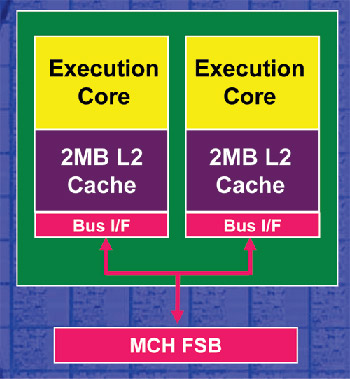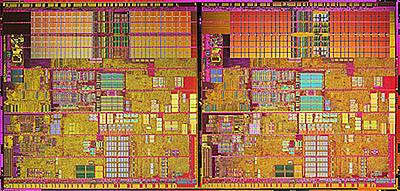 Since Intel did
not have a nice pre-existing resource space in which to add
a second processor core like AMD did, it has been forced
to improvise.
Since Intel did
not have a nice pre-existing resource space in which to add
a second processor core like AMD did, it has been forced
to improvise.
The Pentium D essentially takes two identical P4
'Prescott' processor dies and sticks 'em together. This has the marked
advantage of providing each processor with its own L1 and L2
cache memory.
Unfortunately, Intel's
approach also has the marked disadvantage of forcing both processors to
communicate through the Northbridge and FSB outside the processor, while AMD's
dual-core approach allows the twin cores to exchange information within the
processor itself.
Transistor counts for the new chips hit a high of 230million, and the heat
output is a hefty 130W for the Pentium Extreme Edition 840 and the fastest
Pentium D processors.
Alas, unlike AMD's almost Santa Claus-like decision to keep to the existing
Socket 939 platform for the dual-core CPUs, Intel's dual-core solution
requires a new pair of supporting chipsets, the Intel 955X and 945P.
nVidia's recently released nForce 4 SLI Intel Edition will also support
dual-core processors, but this must be added by the manufacturers so early adopters
are likely out of luck. What it adds up to is that you are going to have
to buy a new motherboard if you want to take advantage of Intel's approach to
dual-core processors.
Heat and Bandwidth: Enemies of Dual-Core
Processors?
While everything we've looked at so far has been positive, let's take a look
at some issues that may affect the performance of dual-core Athlons and Pentium
4s relative to their single core siblings. Given that everything inside
the AMD processor is already adapted for dual-core as we pointed out above,
there are surprisingly few possible pitfalls, but we're going to look at a
couple. Intel's road isn't quite so straightforward.
Heat is one obvious worry. Single core Athlon 64
processors can crank up a fair bit by themselves, as witnessed by the enormous
retail heatsinks they ship with. The same goes for the latest Pentium 4 chips.
What's going to happen when you combine two cores capable of giving off that
much heat in such a small space? Are we going to need mandatory water cooling?
 Apparently not,
as AMD defines almost the same thermal envelope for their dual-core processors as
for the single core versions. The Intel Dual-core chips give off more
heat, but not drastically so.
Apparently not,
as AMD defines almost the same thermal envelope for their dual-core processors as
for the single core versions. The Intel Dual-core chips give off more
heat, but not drastically so.
How is this possible? Well
there are a few factors to consider: First of all, don't forget that both
the AMD and Intel dual-core chips are being produced on the 90nm fabrication
process, like the newest single core chips. As always, smaller fab size =
less power = relatively less heat.
The second factor to consider when trying to figure out why
dual-core processors are not thermal bombs is the slightly slower speed of the
planned processors as compared to their single core equivalent. While not a
huge difference, 400MHz or so less does make them a little cooler.
Finally, there's the fact that at least one core is going to be running at
less than full capacity most of the time.
Bandwidth is a more troubling concern. It's not an enemy of the
dual-core processors per se, but more of a limiting factor. Intel has to
contend with using a conventional FSB/Northbridge setup to allow it's dual-core
processor to communicate with itself, and even with support for DDR2-667 in the
new 955X chipset, this may bog things down. It just doesn't feel like an
efficient way to do things.
On the other hand, the AMD dual-core offerings' internal communications
abilities are doubtless more efficient, but in some ways unproven. We
already know how dual-CPUs talk to each other over a conventional FSB, but AMD's
method of in-chip communication has yet to be really tested. Also the
6.4GBps memory bandwidth of the dual-core Athlons is exactly the same as that of
their single core bretheren.
One major concern when dual-core processors were first announced was how they
would work with operating systems like Windows XP Home, which is limited to one
physical processor. Apparently though, Home users do not need to fret, as
both AMD and Intel's dual-core chips should work just fine. The operating
system will see a single physical chip with two logical cores just as it
currently does with Hyperthreading capable Pentium 4 processors. No word
on how the Pentium Extreme Edition 840 with it's dual cores AND hyperthreading
will work though...
